Today’s Best Recipe is this homemade pizza dough recipe.
It’s perfect for any pizza recipe, pizza pan, pizza stone, or pizza recipe for pizza night.
In fact, I think this easy recipe is the best pizza dough recipe.
This is an easy dough that makes two pizza crusts.
Once baked, it yields a deliciously crisp crust.
It’s so good that you’ll be ditching ordering out once you commit this recipe to memory.
This recipe is great for beginners and the only recipe you’ll ever want to make, as it is easy and produces a soft, homemade pizza crust.
It’s just six ingredients that you, most likely, already have in your pantry!
We all know pizza dough is the foundation of the best pizza on the planet.
The beginning of that crust makes you want to sink your teeth into it.
You can roll this crust thin for a thin, crisp pizza or thicken it up for a thicker crust.
I like a crispy, thin crust on the outside with a soft, chewier crust inside!
Don’t be afraid of the yeast.
It’s going to help your pizza dough rise.
It’s easy to use and will give your pizza dough some lift for an ending perfect for topping with all those delicious pizza additions!
You can make this in the bowl of your stand mixer or by hand–either way; it makes the best homemade pizza dough.
Check our Pinterest Bread Board for more great bread recipes like this homemade pizza dough.
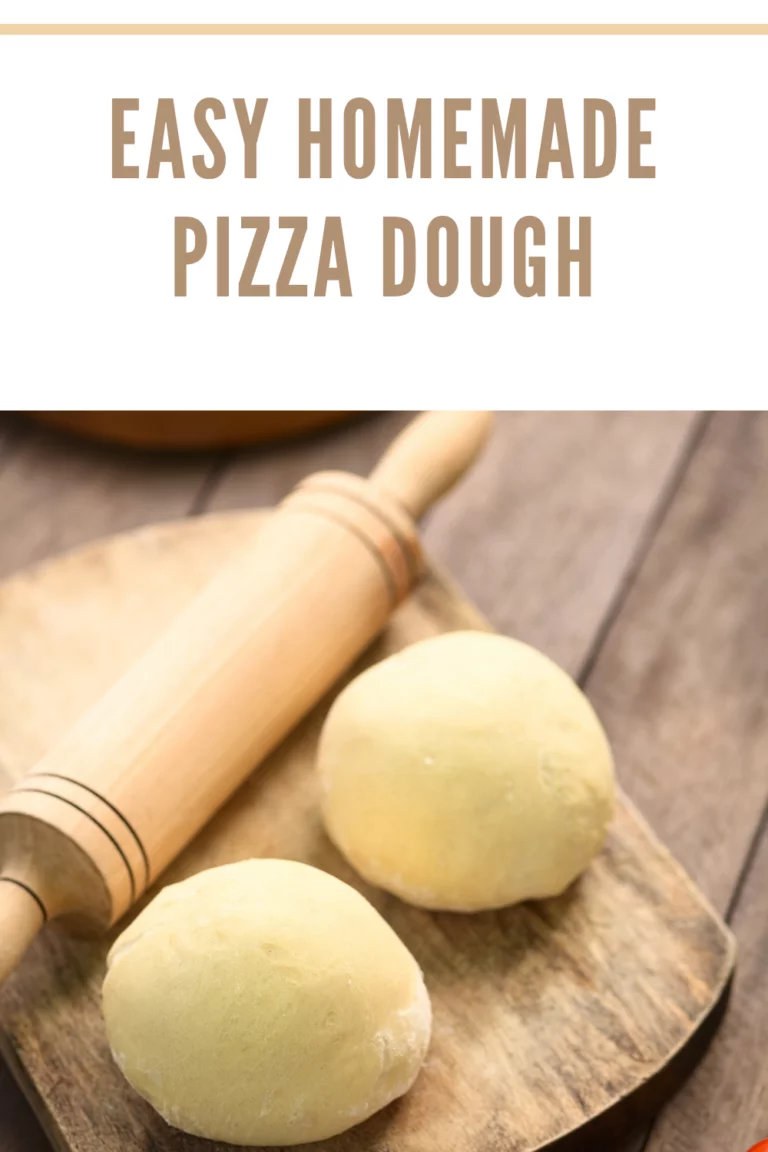
Pizza Dough Ingredients:
- 1 cup warm water, plus extra as needed
- 1/4 cup olive oil, plus extra for oiling the bowl
- 1 teaspoon sugar (or honey)
- 1 package active yeast or active dry yeast (2-1/4 tsp.)
- 3 cups unbleached, all-purpose flour, plus extra as needed
- 1/4 teaspoon kosher salt
How to Make Homemade Pizza Dough:
Mix the water, oil, and sugar in a large mixing bowl.
Sprinkle the yeast on top of the water and sugar mixture and let rest until foamy, about five minutes.
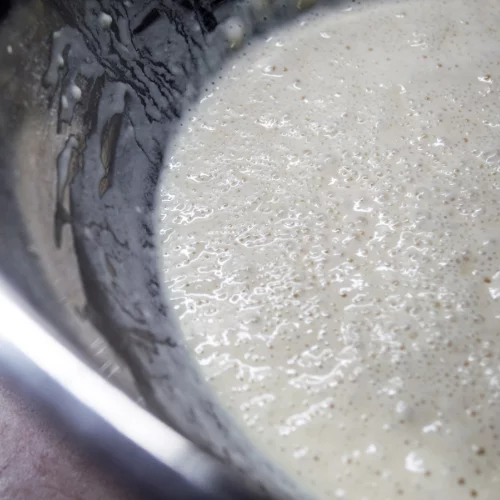
In a medium bowl, combine the flour and salt.
Add the flour mixture to the yeast mixture, 1/2 cup at a time, stirring with a wooden spoon until well incorporated.
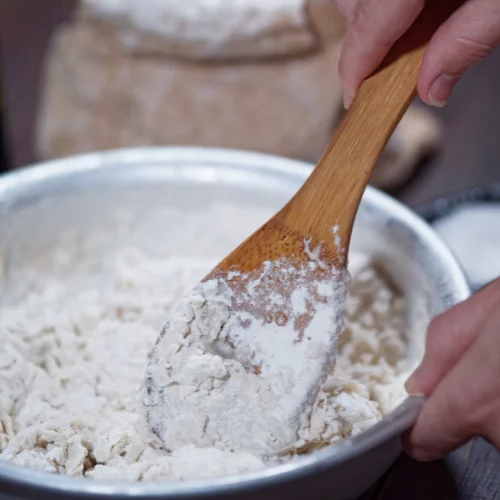
A stand mixer and dough hook work well here; just be careful not to add too much flour. Note: It’s almost impossible to overwork the pizza dough by hand; however very easy to add too much flour if using a stand mixer. Stick to the measurements above for the best results. If the dough is stiff, add more water.
Tip:
If it is very sticky, add extra flour, 1 tablespoon at a time, until the dough is soft and slightly sticky.
Continue to mix until it feels elastic.
Turn the ball of dough out onto a well-floured work surface.
Knead for just about a minute to create a dough that is easy to work with and smooth.
Tip:
You can add additional flour to the surface to prevent the dough from sticking.
You’re just working it enough to get the gluten activated and release air bubbles.
The amount of gluten in the flour creates the texture of the pizza.
Gluten also helps create a stable texture.
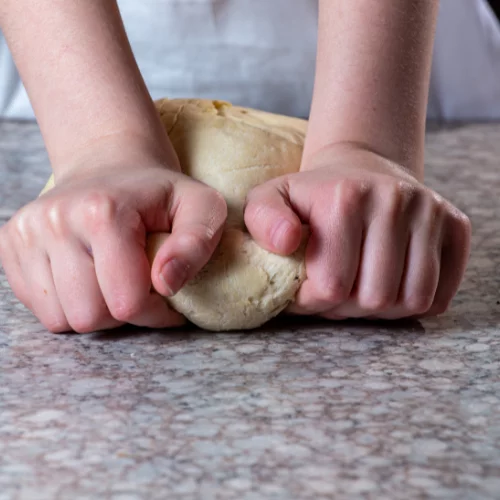
Place the pizza dough ball in a large, clean oiled bowl, turn the dough several times to coat it all over with the oil, then drizzle the top of the dough with a little oil.
Now, it’s time for the first rise.
Cover dough tightly with plastic wrap, place it in a warm place, and let the dough rest until the dough rises more than doubles in volume, about one hour.
Punch the dough down and knead on a lightly floured surface for one to two minutes until smooth.
Tip:
You can opt for a second rise here if you like, though it is not necessary. If you like a light, chewy crust, or a Neapolitan-style pizza, letting the dough rise a second time is recommended. A second rise can be done overnight in the refrigerator or for one hour at room temperature.
Divide dough into two equal-sized balls and proceed with your pizza making.
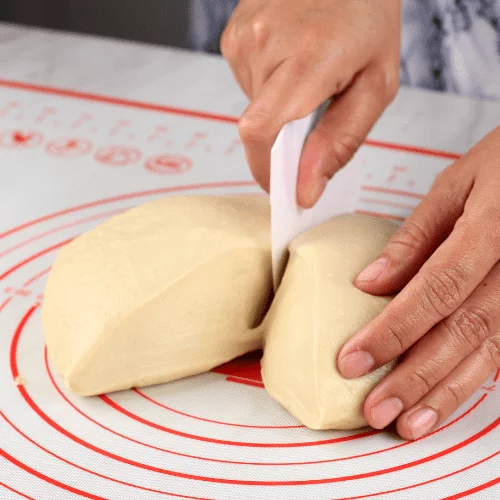
Use a rolling pin to roll the dough out to the size and thickness you like.
You can use it in the pie crust and make a deep dish pizza instead of the Priazzo.
Try it topped with our copycat Pizza Hut Pizza Sauce recipe.

About Proofing Pizza Dough:
Typical pizza dough time to rise is about one hour; however, it can be left in the refrigerator to slow rise for up to 3 days.
Dough may be made ahead of time and frozen for up to one month, thawing at room picture.
The warmer the room temperature or area, the faster the dough will rise. A cooler area will make the dough rise slower (like a refrigerator).
If pizza dough is left to rise for long periods of time, the dough will overproof.
The yeast will consume the sugar and begin to turn to alcohol.
I usually just cover my dough with plastic wrap or a clean kitchen cloth and leave it on my counter.
Other options depend on how soon you want to make the pizza.
If you’re looking for tonight (an hour or so from now), opt for the Oven Method.
Are you starting the dough 3 hours before dinner? The Kitchen Sink Rise is a great option.
Looking forward to family pizza night tomorrow? Try the Refrigerator Rise.
For more than one pizza crust, divide the dough into equal pieces and shape each one before the second rise.
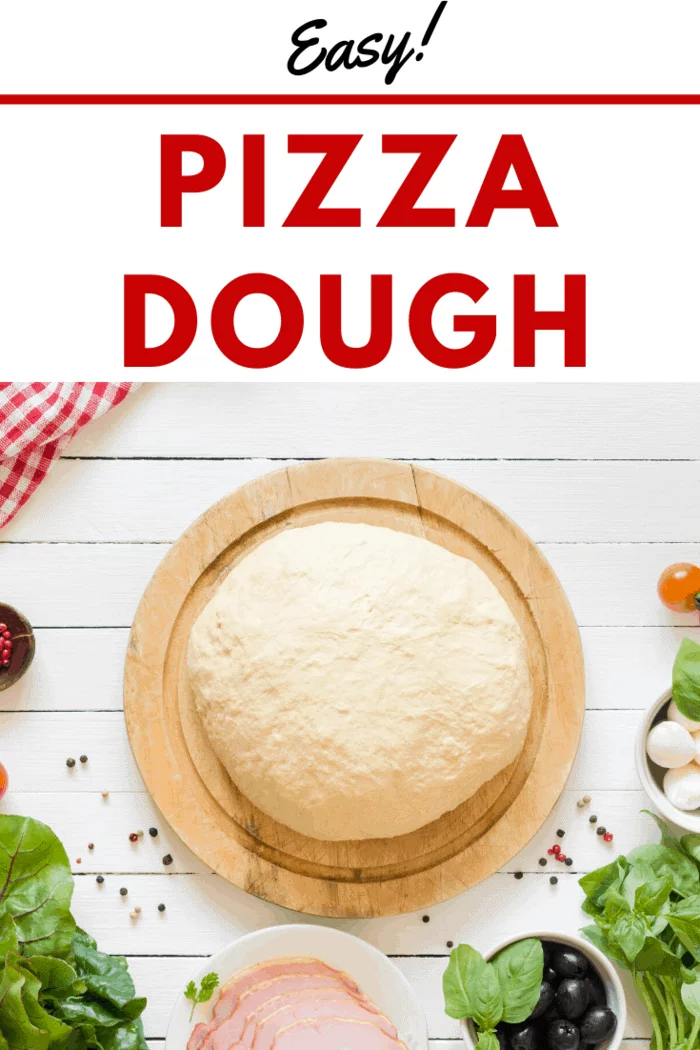
Fastest Rise
- Preheat oven to 150 or 200 degrees
- Put the dough in an oven-safe large bowl
- Cover the bowl with plastic wrap
- Turn off oven
- Place the covered bowl in the preheated oven for up to one hour (until the dough has doubled in size). *I sometimes will add a bowl of boiling water to the bottom of the oven.
Fast Rise
- Place dough in a heavy bowl
- Cover the bowl with plastic wrap
- Put the bowl in the kitchen sink
- Fill the sink with warm water (enough to go halfway up the dough bowl) and place your covered bowl in the water.
- Let the pizza dough rise for 1 – 2 hours
Slow Rise
- Place dough in a bowl
- Cover the bowl with a lid or plastic wrap or place it in an airtight container.
- Place the bowl in the refrigerator
- Let sit overnight
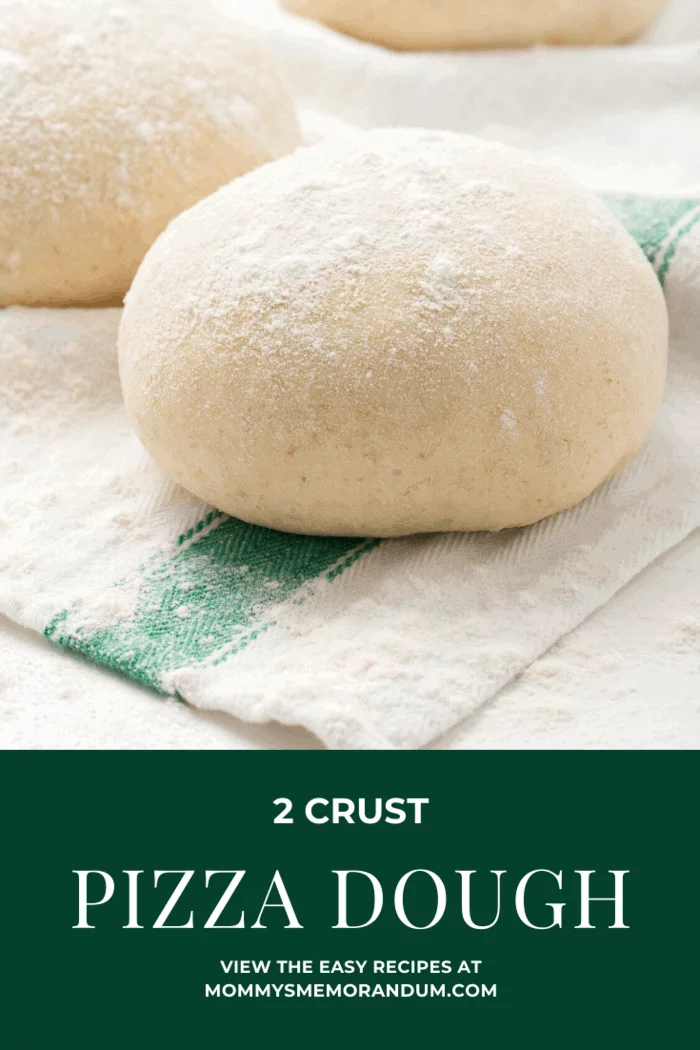
How Can I Tell if My Dough has Enough Rise?
Visually.
The dough will double in volume.
You don’t have to weigh it, just observe if it has increased in size.
The “finger test”
This is the easiest test to tell if the dough has enough rise.
Use your index finger to poke the dough.
The indentation should slightly retreat but remain in the dough.
If the indentation remains open completely, the dough has proofed too long, and the dough will be tough.
If the indentation disappears, the dough still needs rise time.
A Note about the Best Flour:
Different flour will create a different textured pizza dough.
All-Purpose Flour
All-Purpose flour has less gluten than other types of flour. This flour makes a great thin pizza crust. Think Neopolitan-style, deep dish, and New York-style crusts.
This flour is one of the best to use in pizza dough.
Bread Flour
Bread flour has higher gluten and protein than all-purpose flour. This means it will rise high and have more elasticity. The end result will be thick, soft, and fluffy dough with a crispy edge.
Because of the high gluten, this dough will want to revert to its ball state once stretched out. To counter this, roll your dough one inch more than the pan.
This dough is great for those who like a crispy pizza crust on the outside and a chewy crust inside.
Flavored Crust Ideas:
Look no further if you’re looking for a flavored crust for your pizza!
Here are some great suggestions!
Knead one or a combination of these ingredients into your dough before rolling out to create a flavorful crust.
- Rosemary
- chopped fresh or whole basil
- Italian Seasoning
- Olives
- cooked bacon
- Freshly grated Parmigiano-Reggiano, Pecorino, or Parmesan cheese
- Chopped walnuts, hazelnuts, pine nuts, sunflower seeds
- Citrus zest
- Scallions
- Dried fruits
- chocolate chips
- cinnamon
- peanut butter

Homemade Pizza Dough Recipe
Today's Best Recipe is pizza dough. It's easy and creates the most incredible pizza crust. Plus tips for success, including types of flour.
Ingredients
- 1 cup warm water, plus extra as needed
- 1/4 cup olive oil, plus extra for oiling the bowl
- 1 teaspoon sugar (or honey)
- 1 package active yeast or active dry yeast (2-1/4 tsp.)
- 3 cups unbleached, all-purpose flour, plus extra as needed
- 1/4 teaspoon kosher salt
Instructions
- In a large mixing bowl, combine the water, oil, and sugar.
- Sprinkle the yeast on top of the water and sugar mixture and let rest until foamy, about five minutes.
- In a medium bowl, combine the flour and salt.
- Add the flour mixture to the yeast mixture, 1/2 cup at a time, stirring with a wooden spoon until well incorporated.
- A stand mixer and dough hook work well here; just be careful not to add too much flour.
- Note: It's almost impossible to overwork the pizza dough by hand, however very easy to add too much flour if using a stand mixer. Stick to the measurements above for the best results.
- If the dough is stiff, add more water. If it is very sticky, add extra flour, 1 tablespoon at a time, until the dough is soft and slightly sticky.
- Continue to mix until it feels elastic.
- Turn the ball of dough out onto a well-floured work surface.
- Knead for just about a minute to create a dough that is easy to work with and smooth. YOu can add additional flour to the surface to prevent the dough from sticking. You're just working it enough to get the gluten activated and release air bubbles.
- The amount of gluten in the flour creates the texture of the pizza. Gluten also helps create a stable texture.
- Place the pizza dough ball in a large, clean oiled bowl, turn dough several times to coat all over with the oil, then drizzle the top of the dough with a little oil.
- Now, it's time for the first rise.
- Cover dough tightly with plastic wrap, place in a warm place, and let the dough rest until the dough rises more than doubles in volume, about one hour.
- Punch the dough down and knead on a lightly floured surface for one to two minutes, until smooth.
- You can opt for a second rise here if you like, though it is not necessary. If you like a light, chewy crust, or a Neapolitan-style pizza, letting the dough rise a second time is recommended. A second rise can be done overnight in the refrigerator or for one hour at room temperature.
- Divide dough into two equal-sized balls and proceed with your pizza making
Nutrition Information:
Yield: 32 Serving Size: 1Amount Per Serving: Calories: 59Total Fat: 2gSaturated Fat: 0gTrans Fat: 0gUnsaturated Fat: 1gCholesterol: 0mgSodium: 11mgCarbohydrates: 9gFiber: 0gSugar: 0gProtein: 1g
The Nutritional Information may not be accurate. This website provides approximate nutrition information for convenience and as a courtesy only. Nutrition data is gathered primarily from the USDA Food Composition Database, whenever available, or otherwise other online calculators.
